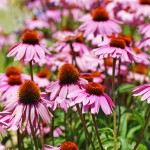Often times we simply just look at flowers. We admire their beauty and grace, and never stop to think of what more they might be able to offer. Many flowers that are commonly found in bouquets are also edible or have been used for medicinal purposes*. Sometimes they are mistaken for weeds or wildflowers. These flowers are frequently found in flower beds as well as florists’ shops.

Feverfew
Feverfew is known by many names and is a relative of the chrysanthemum. This delicate, white flower looks similar to a daisy and may be mistaken for a common weed. They grow in barren places outdoors, but can also be grown indoors or found in gardens. They can become invasive.
Feverfew has been used for hundreds of years to treat migraines. The leaves can be eaten directly, but are said to be bitter or can be brewed into a tea. Feverfew also has anti-inflammatory properties and has been used to treat arthritis, allergies, and insect bites.

Marigold
Marigolds are a favorite among florists. With their brightly colored blooms in yellow, orange and red, these annuals are an eye-catcher. They are known as the flowers of the Aztecs and are a major theme in the Mexican Day of the Dead celebration. Marigolds are hardy and will grow most anywhere.
Marigolds are known as “poor man’s saffron.” This is due to the color they bring to dishes rather than having a flavor similar to that of saffron, and they are frequently used as a natural food coloring. The marigold flowers can also be brewed into teas or added to salads and other dishes. Marigold is extremely useful for skin ailments, acting as both an anti-inflammatory and repair agent when prepared properly.

Purple Coneflower
The purple coneflower is a lovely blossom that is usually regarded as a wildflower. It is also used in multiple ways for floral arrangements. The flowers make a wonderful addition to any design. They can also be dried and the brown center, or cone, used for accent pieces.
Better known as Echinacea in the medicinal world, the purple coneflower is said to have immune system boosting qualities. Studies have shown that Echinacea can help treat or prevent upper respiratory infections like the common cold.
Cornflower
Also called the Bachelor’s Button, this beautiful blue bud has grown wild for centuries. Historically the Bachelor’s Button was worn by young men and women to signify availability. Due to their long lasting nature, these true blue flowers make an excellent addition to traditional arrangements.
The cornflower is used as natural blue dye. It has also been used to treat a slew of ailments. The petals can be brewed into a tea to help stomach troubles. It has also been used in poultices to soothe tired eyes and muscle aches.
The next time you admire that beautiful bouquet from your special someone, remember those pretty blooms may be more than they appear. These are just a few examples of the many flowers you can find at your local florist that may be more than what they seem! Visit your local florist today!


 Find Your
Find Your 

Speak Your Mind